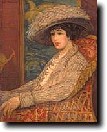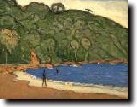

Part 1 James Wilson Morrice (1865-1924) - part 2
Until now, Morrice had painted mostly landscapes; Blanche, exhibited in 1912, is the first of a series of portraits and model studies (note that the screen in the background is the same in the two works). He will pursue this series during World War One, when travel was more difficult.
At the beginning of the war, in February 1915, Morrice visits Cuba with Canadian friends. He often came back to Montréal, usually around Christmas; the visit of 1914, unfortunately saddened by the death of both his parents, will prove to be his second to last.The artist often brought paintings with him, and sent them to the annual Salons: Art Association of Montreal, Royal Canadian Academy. Canadian critics, more aware of the recent developments of art in Europe, as well as of Morrice's Parisian success, finally recognize his talent. But it is too late: disappointed by the lack of sales, Morrice stops exhibiting in Canada after 1916.
The post-war years are saddened by illness (stomach problems linked to alcohol abuse) but, around Christmas 1920, well again, Morrice spends a few weeks in Canada, painting around Québec City. He then spends a few weeks in Trinidad, before going back to Paris.
Trinidad marks the beginning of a new period: having abandoned the wood panel sketches for watercolours, Morrice transposes its technique, lighter and more fluid, into the paintings done after his trip: freer style, very light paint, contours underlined in a slightly darker tone; a reminiscence of Gauguin, perhaps, but the Canadian Morrice prefers colder tones.The watercolours he brought back from a trip to Algiers at the beginning of 1922 continue in this style. We can even find an echo of Cézanne, which Morrice admired, in some Algerian compositions, although Morrice never tried to use Cézanne's complex spatial constructions, prelude to Cubism, which the Canadian painter never understood.
In spite of a relapse of his illness, Morrice goes to Tunis in January 1924; he does not have time to work: he dies on the 23th, after a few days in hospital.
Above: Copyright © 1998, Lucie Dorais
Morrice spent almost thirty-four years in Europe, mainly Paris, where he achieved notable success. However, he never completely lost touch with his native land, and played a significant role in the evolution of Canadian painting. It is through his works and those of other painters who were then studying and working in Paris, that young Canadian artists were able to learn about recent developments in European art. Other painters certainly influenced Morrice during his career. The artistic stimulation he sought from them, rather than a weakness, gave this diffident man the freedom to express the poetry and music that were central to his own creativity.This paragraph: Copyright © 1985, National Gallery of Canada
Last updated: April 22, 2000Top of page | J.W. Morrice | Home




